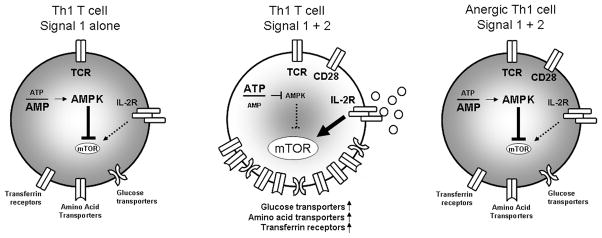FIGURE 5.
Anergic T cells are metabolically anergic. Thompson and colleagues have proposed that when a T cell receives signal 1 alone, it fails to fully up-regulate the metabolic machinery necessary to support T cell activation (left panel) (3). As such, a major function of costimulation is to facilitate metabolic function necessary to fuel the T cell response. We propose that just as anergic T cells fail to produce IL-2 upon rechallenge with full stimulation (signals 1 plus 2), they also fail to up-regulate the metabolic machinery such as the transferrin receptor, amino acid transporters, and glucose transporters necessary to promote a full effector response (right panel). IL-2 has the ability to activate mTOR; however, in the absence of signal 2 (left panel) or when a cell is anergic (right panel), very little IL-2 is produced. In the presence of costimulation (middle panel) AMPK is modestly activated (see Fig. 4B); however, this is not enough to inhibit mTOR in the setting of full activation. Thus, in the absence of energy, glucose, or amino acids mTOR is inhibited, resulting in the induction of anergy. Likewise, a dearth of these nutrients or the inability to import and metabolize these nutrients can directly inhibit T cell function.

